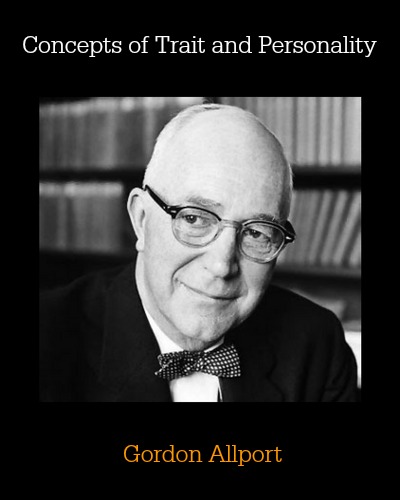Psychology Classics On Amazon

Concepts of Trait and Personality
The Article in Full
Bibliographies by May and Hartshorne, Manson, and Roback bear out the statement of G. B. Watson that "It is almost impossible to find a trait for which an adjective exists which has not been approached with some degree of suggestive investigation." Confusion has arisen from the fact that these investigations, with their ambition to determine magnitudes, give only an occasional glance at problems of terminology and theory.
On heuristic grounds it is, of course, possible to advocate measurement to the temporary neglect of theory. Symonds believes that since we are never sure of the existence of traits nor of their definition, we should center attention upon reliabilities and let even validities await their turn. But the same writer has pointed out in another connection that "attitudes" are defined in at least seven different ways by educators and psychologists. It is such confusion as this that retards the interpretation of reliabilities which Symonds is anxious to see established, and is generally prejudicial to advance in the field. Not only "attitude" but "disposition," "factor," and, above all, "trait" are employed vaguely to suit the needs of the moment. With such disingenuousness investigators have made it appear that quantitative distinctions can outrun qualitative, and that adjectival distinctions can outrun substantive. The truth of the matter is that neither measurement nor inventories of "attitudes" and the like can be intelligible until the substantives themselves are clearly understood.
The same term is frequently employed by a single writer to represent distinctly different levels of behavior. This method is found in its extreme form in Davenport's Trait Book, where tics, affability, and love of fishing are presented as parallel manifestations of personality. Marston speaks of introversion and extroversion as emotional traits, and then lists twenty traits of introversion and twenty of extroversion. There is recognition here of at least two levels in behavior but both levels bear the same name. Ironically enough, Edman, after employing "trait" with almost the breadth of Davenport, remarks: "Social sciences will never attain the precision of the physical sciences until it also attains as clear and unambiguous a terminology."
There is likewise confusion between personality devaluated and personality evaluated, that is, between personality and character. To be sure, Watson, followed by many others, has marked the difference between the two. In practice it is a difficult but not an impossible distinction to maintain. The same behavior psychologically speaking may be moral in one locality, immoral in another, moral at one period of time, immoral at another. There are no "moral traits" until trends in personality are evaluated. Tests which deal with morality admit an extra and uncertain variable. For example, in obtaining an estimate of a child's "knowledge of right and wrong," results must vary according to the environment taken as a standard. "There seem to be different codes for the different situations, such as a home code, a school code, a Sunday school code, a club code" (Hartshorne et al.,). By which code shall the personality of the child be judged?
There is also confusion between personality and the factors underlying personality. Tests for physique, for intelligence, or for temperament are not tests of personality. It is not physique which acts, nor intelligence which acts, nor temperament; it is the person who acts. If, then, personality is the object of inquiry, traits of personality should not be confused with qualities or quantities of intelligence, physique, or temperament. These latter factors are merely convenient abstractions by way of which psychology has arrived at the problem of human personality. Inventories of "traits" at present include a reckless array of non-comparable factors. Kantor, e.g., frankly employs the term to cover each and every capacity and abiding attitude of the human organism.
This practice would suggest the view that traits have merely a nominal existence. Such indeed is the attitude of Symonds, who regards them as dangerous fictions like the faculties of old. If "traits" are merely nominal entities, there is still the problem as to what constitutes the existential unit of personality. In the section which follows contributions are reviewed which bear upon the problem of the nature of this unit. For convenience it is proposed to rescue the term "trait" from the confusion in which it is embedded and to apply it consistently to designate the unit sought.
DEFINITIONS OF TRAIT
1. As An Independent Statistical Variable.
Studies using the quantitative approach tend to derive the definition approximately as follows: A trait is a tendency to reaction which when measured with reliability demonstrates an independence of other variables. Cady objects to the use of the term "trait" in any other sense, and thinks by such delimitation a schedule may eventually be prepared of basic or generic elements in personality. Thorndike says, "Let a 'single trait' be defined as one whose varying condition in men can be measured on one scale. A combination of traits requires two or more scales."
Some investigators insist upon the lack of cohesion between traits thus defined, even at a low level of organization. Thus, Trow from experimental results concludes: "It would seem that little is to be gained from talking about speed of decision as a trait, if we mean by that that it is possessed in a constant amount by any one person, and used in that same quantity with slight variation on all occasions." This lack of consistency he also reports to be characteristic of confidence, and ventures that the same conclusion will hold for other traits as well. He professes an open mind, however, as regards certain traits, such as neatness and a sense of humor.
Working with sixth grade children, Dowd made an investigation, bearing upon the common contention that there is a quick type of person and a slow type. Utilizing very simple tests, she found that "rate is not to any appreciable extent an individual characteristic consistent for different performances." The only high correlations obtained were between tests having very similar content. The range of coefficients was from .136 to .870, but with a preponderance at the low end. Dowd's findings are typical of the studies which are offered as evidence for a lack of correlation between mental abilities and as support of the nonfocal theory of intelligence. The dispute concerning levels of organization in intelligence may be expected to have its counterpart in the problem of levels in personality. A few recent studies (vide infra) presage theories of multifocal organization in personality. For a unifocal theory it is still necessary to refer to Webb's hypothesis of a "g" factor of a characterial nature.
The view that traits are specific, nonfocal reactions has, of course, long been maintained. Thorndike stresses the "singularity and relative independence of every mental process, the thoroughgoing specialization of mind," and to explain the apparent inclusiveness of traits he leans upon the Law of Partial Activity. Symonds proposes the term "confact" to designate this constant conduct response to the common element of different situations.
Perrin and Klein, from the approach of theory rather than experiment, claim likewise that "traits are responses conditioned upon specific stimuli," and "must be defined in terms of a particular stimulus and a particular response." Traits are transferable to other stimuli only to the extent indicated by studies of transfer of training. In this as in everything they behave like habits simply because they are habits possessed of social significance. Traits become predictable to the extent that identities in stimulus situations are predictable.
Not all of the statistical studies can be interpreted to favor this view of specific, nonfocal response. Kelley maintains that since "cleverness" (Garnett) and "social interest" (Wyman) are demonstrably related they are "probably just different aspects of a single underlying trait." This trait in turn is demonstrably different from, say, "persistence of motives." Kelley likewise points to aggregations of traits which suggest super-traits or type-traits. The characteristics of type-trait are: (1) that a direct or indirect quantitative measure of it exists, (2) that in a given age group it exists in amounts which correlate to the extent zero with other measured traits, (3) that this zero correlation stamps the type-trait with a peculiar value in interpreting mental life. It is interesting to note that the result of this approach is the discovery of three outstanding type-traits which parallel closely, so far as they go, Spranger's Lebensformen, viz., the social, the political, the economic.
Other constellations, of not quite so high an order, are reported. Freyd finds co-variation in respect to talkativeness, flexibility, present-mindedness, good-nature, and quickness in work. Heidbreder discovers that Freyd's fifty-four criteria for extroversion-introversion with few exceptions form "a consistent set of traits." The reviewer in a study yet to be published has found evidence of a similar agreement among habits which comprise the trait of ascendance.
Certain quantitative studies then, while not denying the presence of isolated habits in personality, find a tendency for them to group themselves, to adhere in complexes forming units of a higher order.
2. As A Contingent Higher Unit.
Other psychologists take the genetic approach. The notion of the compounding of reflexes and the doctrine of the conditioned response underlie these contributions. Sherrington and Pavlov (the latter innocently) have entrenched belief in a hierarchy of habits. When applied to personality two questions arise: (1) How high on the motor side may the hierarchy extend? (specifically, How generic may the motor attitude become through integration?). (2) How nonspecific may the stimulus become? i.e., How far from the original stimulus may the effective stimulus recede? Neither question has been answered explicitly, although both are vital to the theory that traits are built through conditioning and compounding. Answers by implication are offered by the following writers:
Bridges presents a thoroughgoing hierarchy consisting of (a) hypothetical elements, (b) simple but observable elements, (c) knowledge (cognitive), minor sentiments (affective), motor habits (conative), and (d) intellectual world view (cognitive), major sentiments (affective), and a "general motor attitude" (conative). Watson proposes a less extravagant hierarchy in a conditioned reflex level and a later habit level. Burnham speaks of conditioned reflexes, habits, or systems of conditioned reflexes, attitudes, and generic attitudes.
Carr considers that every act exhibits its own specific genetic history and also "special features which reflect some more general characteristic of the self," e.g., cordiality, reserve, pride, caution, etc. The organization of such special features into higher units proceeds, he says, distinctly according to the principles of contiguity and assimilation, that is, in strict conformity with the laws of association. Paton likewise claims that all complex responses which become the criteria for differentiating the behavior of one individual from that of his fellows are the operation of reaction systems gradually evolved through the integration of simpler reflexes. The origin of these systems can often be traced step by step.
From such points of approach the following approximate definition of trait might be formulated: A trait is a dynamic trend of behavior which results front the integration of numerous specific habits of adjustment, and which expresses a characteristic mode of the individual's reaction to his surroundings.
3. As A Noncontingent Higher Unit.
An attack has been launched by Humphreys against the assumption that the conditioned reflex is the unit of habit. "One who reads the account given by Pavlov and his workers is forced to the conclusion that the mechanism described is qualitatively different from that which, say, James treated in his chapter on habits." The significant differences are the conditioned reflex readily disappears through disuse; it is easily inhibited by slight extraneous stimulation; it revives under conditions not normally influencing habit. More recently Pavlov himself has shown that his endeavors to elaborate conditioned reflexes to form higher units usually lead to the inhibition of reflexes already present, to a regression to a still earlier reflex, or to diffuse cortical inhibition (sleep). To Humphreys the conditioned reflex is "a simplified type of habit rather than a unit." Mursell also assembles evidence which he thinks proves that "the proposal to regard the segmental reflex as the ultimate unit of behavior" definitely breaks down. Akin to this view are the pronouncements of Gestalt psychology. Koffka regards habit as a "closure" resulting not from association but directly from "collective apprehension" and meaningful, motor structuration. Ogden adds: "Instead of supposing that the organism is equipped at start with a number of reflexes that become integrated, or associated, by a kind of linkage into instincts and habits, we have found ample reason to believe that a total response of the entire organism precedes any differentiation of partial activities."
A view which ascribes a different sort of independence to traits is that which regards a driving power as absorbed into the higher units. From such a standpoint it is immaterial whether the higher units originated from integration; the prominent fact is that they lead an existence sui generis Thus, Woodworth speaks of mechanisms becoming drives. Troland, after tracing the growth of "complexes" in the child by trial and sensory pleasure and pain, points to the reciprocal phenomenon: under the control of such complexes habits are subsequently formed which are congruous with the complex itself.
Morgan originally called the control exerted by the higher units over the lower "selective synthesis." He has more recently treated this phenomenon as a manifestation of emergence. While admitting that higher levels involve lower, he insists that, far from being functionally dependent upon them, "one may say that the higher kind of relatedness guides or controls the go of the lower level." Emergence has been applied more specifically to personality by Gordon: "So at whatever level we are examining personality, we must remember that the particular type of relatedness we are concerned with involves all other forms of relatedness below it but it is not a mere summation of these, but a definite new entity of its own, different from its components and from everything else." It must, however, be urged that the doctrine of the existence of directive higher units in behavior does not depend for its validity upon the philosophy of emergence.
The conclusions to be drawn from the opinions just assembled are the following: A trait probably does not reside in a specific "habit-groove" to be activated by a constant stimulus (acting as a whole or ecphorically). A trait is functionally independent of its origins, even if its origins can be traced to the compounding and conditioning of reflexes (which Humphreys, Mursell, and others doubt). A trait is known not by its cause, but by what it causes; not by its roots but by its fruits. Any given moment of behavior will be determined in part by the exciting stimulus, but also in part by the complex higher units in personality. This process is spoken of by Bentley as "contributory habituation," wherein nonhabituated behavior takes place under the general guidance of habits, and on the other hand habituated functions are performed in close cooperation with the specific activities aroused by the stimulus of the moment. From this point of view behavior shows a dual determination: specific and general. The latter, of course, is the type of determination manifested by traits. A trait then might be defined as a general and habitual mode of adjustment which exerts a directive effect upon the specific response.
The Personality As A Whole.
The definition of the unit of personality is one problem pressing for solution. Equally insistent is the demand for a theory as to the way in which units are related in personality. Griffith writes, "The fusion of unnumbered experiences into a single unit bearing a total character of its own or the fusion of behavior patterns of different kinds into consistent and internally coherent systems is a problem that the psychologist has barely touched. Even his generalizations about a 'common factor' are vague in the extreme. A problem lies here, however, that cannot be ignored. That totality of mental life and behavior called 'personality' or 'character' is, perhaps, the most unique thing about the human organism." The first step in the solution of this problem is to determine to what extent a personality is to be treated as an integer. If it is a true integer, then each trait must reflect but an aspect of a synthesis in which all components are congruous. Under such a condition it would be true of the personality, as Lavater said of the human body, that no member contradicts another, for each has the character of the whole.
Garnett has sought to determine whether an index of integration can be prepared for a given personality. "A well integrated personality is one in which the various habit-systems show no marked disagreement." Using ratings as his criterion be concludes tentatively that in some individuals at least a consistency around a level is found to exist, and that estimating from the results of partial correlation abstract and social intelligence play an appreciable part in determining this consistency. Using a variety of tests, dealing with thirty-five talents and traits, Hull found that the variability measured within the individual is roughly 80 per cent as great as the variability within a normal group. But individuals differ in variability, so that in some the range is twice as great as in others.
An integrated personality to Young is "one which is organized around some set of facts or specific aspects of the environment, around some values if you will." Integrity means organization. But dissociation in personality is as true a phenomenon as integration. "Dissociation is a method by which the personality utilizes one part of the organism independently of the antagonistic trends of the personality." Such dissociation is at times invaluable for survival, but ordinarily it implies a division of power and hence inefficiency. Young, then, as well as Hull and Garnett, indicate that both integration and the lack of integration are characteristics to be dealt with.
Most of the studies up to the present time have treated personality as unintegrated, attention being centered upon some trait in isolation. Few treatments of the whole personality have appeared. Twenty-four years ago Morgan stated his belief that "character" evolves into a pattern "determined by the intrinsic laws of mind, just as a crystal is evolved along lines which are determined by the intrinsic laws of crystallization." This point of view has been carried forward in a brilliant exposition by Spranger. That unity of personality which is so apparent to the naive eye is apotheosized by Spranger as a Wertrichtung under which the individual acts of a person are coordinate. Taking Spranger as a point of departure the reviewer has shown that the "form-quality" of the whole personality is amenable in part to objective methods of investigation, and in part only to inferential characterization. Roback (like Spranger and Young finds the center of gravity in personality in the values held by the person. There is an inborn urge to consistency which forces the individual to strive toward unification in his acts. If his values are in this way achieved through the rational inhibition of instinctive impulses, the individual, according to Roback, has attained "character."
To such approaches it has been objected, as was pointed out earlier in this review, that people respond very specifically, not at all consistently, and that the personality does not represent a unit. This view is as extreme as Spranger's. One contention treats the acts of personality as nearly devoid of consecutive relation as, say, the excursions of a vehicle. The other view flatteringly ascribes an inherent (and innate) Wertrichtung to the poorest and most casual of personalities.
English points out that behavior as the "response of a complete and integrated organism" is a fiction, since "no act is ever a response of the 'whole animal'; no organism is ever wholly integrated. Integration is a matter of degree." Spranger's method tends to disregard the disunities in personality. On the other hand, the majority of contemporary investigators pay far too little respect to the underlying unities. Integration in personality is a matter of degree.
Conclusions.
A consideration of the more conclusive studies suggests five basic requirements in procedures for investigating personality: (1), the recognition of "trait" as the unit of personality, (2) the admission of a probable hierarchy of traits, certainly of unit tendencies higher than the level of specific habits, (3) an approach to the problem of the limits of generalization in the most comprehensive traits, (4) the admission of both a major synthesis in personality as well as minor syntheses and dissociated acts, (5) the tentative admission of subjective values as the core of such syntheses, but the exclusion of objective evaluation (character judgments) from purely psychological method.
This Psychology Symbol - Vintage Retro Striped Sunset T-Shirt is available from Amazon (prime eligible) in a range of colors for women and men. Sales help support this website, which has been providing free and comprehensive information and resources for psychology students and educators since 2008.
Recent Articles
-
Billy Milligan Case Study: Psychology, Crime, and the Split Mind
Apr 18, 25 09:10 AM
Was Billy Milligan a fractured victim—or a manipulative genius? This Billy Milligan case study explores the psychology behind one of history’s most controversial trials. -
Borderline Personality Disorder: More Than Mood Swings
Apr 18, 25 07:11 AM
Discover key facts about Borderline Personality Disorder, its symptoms, causes, treatment options, and why raising awareness is vital. -
Psychology Book Marketing
Apr 17, 25 04:56 AM
Psychology book marketing. Ignite your book's visibility by leveraging the massive reach of the All About Psychology website and social media channels.
Please help support this website by visiting the All About Psychology Amazon Store to check out an awesome collection of psychology books, gifts and T-shirts.
Go To The Classic Psychology Journal Articles Page






